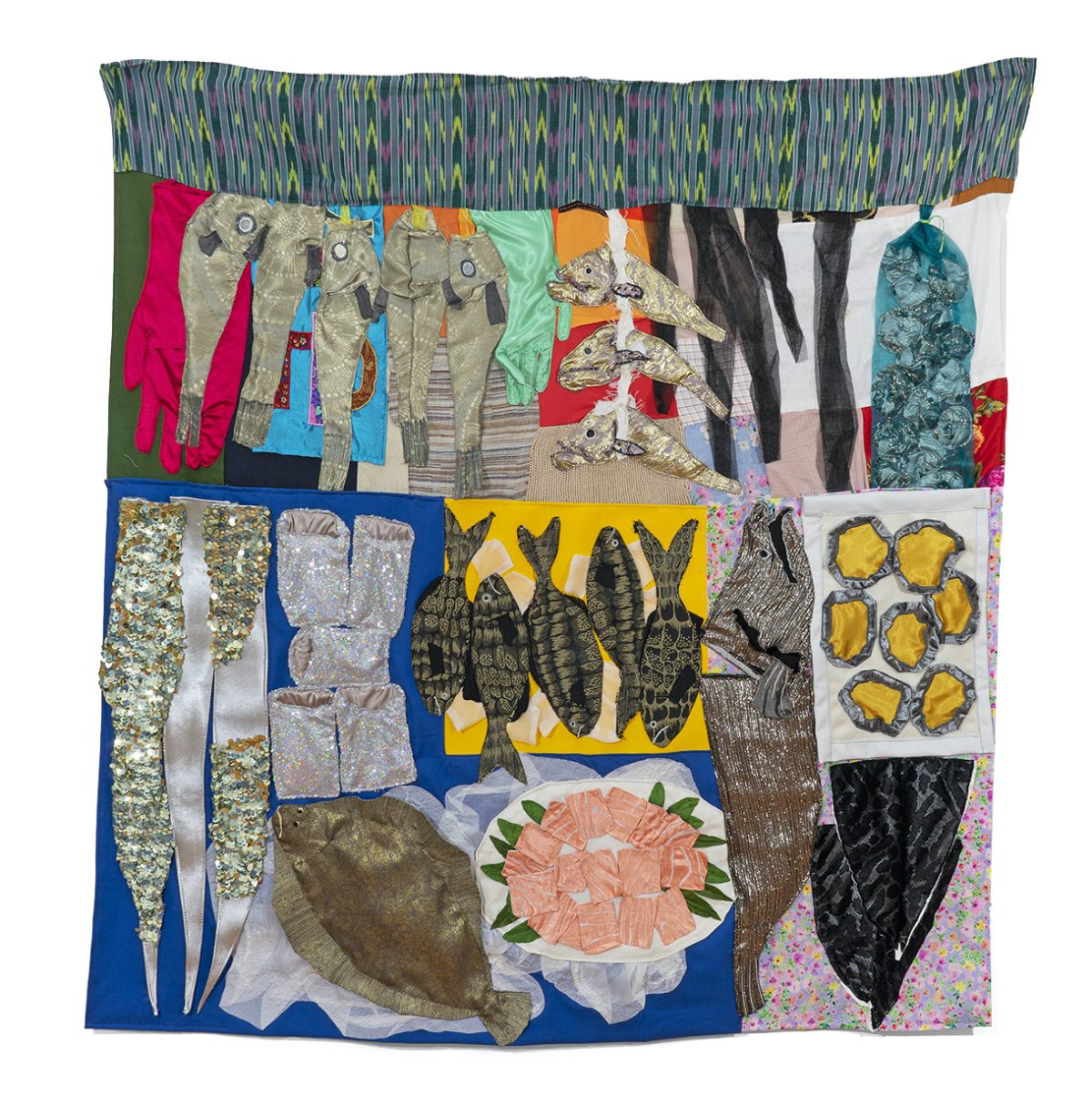
The English translation of the Korean word Shi Jang is “market.” The markets in Korea are the inspiration for Woomin Kim’s ongoing series, collectively titled Shijang Project. Kim stated in 2021: “This is the place that I used to go all the time growing up. And whenever I visit Korea, it’s one of the first places I go. […] In my quilts, I describe the different kinds of merchants, stores, and material assemblage that you can see in these kinds of open-air markets. It’s such a vibrant place, with a fish market next to a fabric market and all different kinds of energy.” The particular visual abundance she describes can be experienced in her wonderfully dizzying debut exhibition, Woomin Kim: The Shijang Project at Susan Inglett Gallery (June 9–July 29, 2022).
Kim is part of a growing generation of artists from Asia who earned undergraduate degrees in their birth countries and then immigrated to the United States to further their studies, and in some cases to stay. After receiving her MFA in 2015 at the School of the Art Institute of Chicago, Kim relocated to New York City, where she discovered an equivalent to Korea’s outdoor markets in Queens.

The 10 collage-like quits in the exhibition, all between five and six feet in diameter, are polychrome extravaganzas that invite viewers to marvel at what can be achieved with fabric. Joining abstract forms with objects as specific as dried fish and leopard-print shoes, Kim’s attention to detail, color, and texture results in a massive inventory of items created through an imaginative use of distinctive materials. She possesses a nimble, droll, and acutely sharp sense of mimesis. By incorporating material that may actually be part of the item she is representing — a mop or pair of shoes, for example — she nudges the American trompe l’oeil tradition of John F. Peto and William Harnett into fresh territory.
At the same time, Kim’s work pushes back against such slick portrayals of material goods as Andreas Gursky’s supermarket photographs, Andy Warhol’s silkscreened Coca-Cola paintings, and Haim Steinbach’s minimalist displays of commodities. In contrast to Warhol’s insistence on sameness and his flattening of experience or Gursky’s association of abundance with waste and indiscrimination, Kim shows the nomadic side of global capitalism, that of the small shopkeeper who runs an outdoor stall temporarily set up in a designated part of a city.

Kim replaces sameness with difference. In “Shijang: Shoe Store” (2021), she has used different materials and patterns to fashion more than two dozen kinds of footwear, from boots to clogs to sandals. Even when the pattern is the same, as in two single boots in the lower left quadrant, the colors are different. Although some manufacturers’ names are scattered throughout the display, there is no sense that any one pair is more desirable than the others, and there are no designer sneakers. The bare lightbulb hanging from a black cord in the upper right quadrant establishes the setting. This is about necessities rather than high fashion. And yet, an interest in pattern and color is present everywhere.
Kim’s delight in turning a piece of fabric into something as mundane as the pattern inside a boot or shoes is evident. This is the opposite of Warhol’s aesthetics of boredom and fascination with mechanical reproduction. As her works convey, boredom is not an option, but a privileged position, when survival in a new environment depends on hard work. Her art is based on the activities of cutting and sewing, of activities we often associate with making garments.

Kim’s celebration of an alternative economy also brings to light the determination of many immigrant cultures to maintain certain practices and traditions, such as a region’s cuisine or medicines and cures. Her resistance to the destruction of difference that Warhol recognized as one of the cornerstones that America was built on is admirable. Her art makes no overt claims to be political, but on so many levels it is, from the craft of her quilts to the crafts she represents; from her recognition of everyday life as a constant struggle for economic survival to the flexibility and adaptiveness that characterizes many immigrants in the US.
At the same time, Kim’s use of collage and her hallucinatory juxtapositions of pattern and color rethink aspects of the Pattern and Decoration movement of the 1970s, and its interest in different styles of Asian art. In “Shijang: Ribbon Store” (2021), the artist stacks ribbon spools in various patterns. Despite the flatness of her materials, she composes a shallow space that includes shelves and the edge of a cloth-covered table, which spans the quilt’s bottom edge. The attention paid to something as disposable as ribbons, and the way Kim arranges them on the table, underscores a very different aesthetic disposition than the typical American emphasis on mass production. Within this polyphonic gathering, no pattern or color is overshadowed by another. Each one contributes to the entire composition while maintaining its distinct identity. That is masterful.

Woomin Kim: The Shijang Project continues at Susan Inglett Gallery (522 West 24th Street, Chelsea, Manhattan) through July 29. The exhibition was organized by the gallery.
0 Commentaires